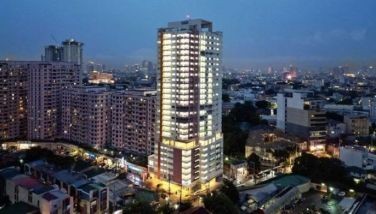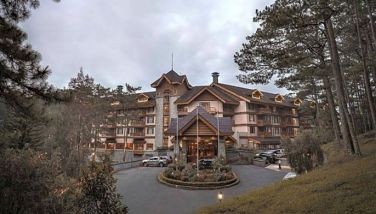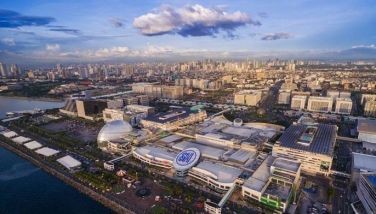Davao high value fruit trees winning ventures in Luzon
April 6, 2003 | 12:00am
Durian (Durio Zibethinus) is an attractive evergreen tree with pyramidal canopy. Recommended varieties are durian monthong from Thailand and D24 from Malaysia.
Growing durian from seeds is not advisable. With this method of propagation, it can grow up to 45 meters making harvesting difficult. The other disadvantage is that it will bear fruits only after 10 to 12 years — a very long time that will take the edge off a winning venture.
Pomologist Bernie Dizon who has a contract to propagate excellent fruiting trees at the Ninoy Aquino Parks and Wildlife Nature Center at the Quezon Memorial Circle and North Ave., Diliman, Quezon City advises an exceptional alternative. At his DENR-PAWB-Dizon botanic fruit demo-farm where he conducts seminars for free on Sundays, he recommends to hobbyists, orchard growers, retirees and entrepreneurs to plant double rootstock cultivars to make the durian tree crown low for easy harvesting. Double rootstocking makes for strong trees that can withstand typhoons and adverse weather condition.
Compared with planting materials from seeds which bear fruits after 10 to 12 years, double rootstock durian trees reduce fruiting time to one-third (three to four years). First fruiting can yield 10 kilos and double that volume in the succeeding years. Eight- to 10-year old trees can bring off 100 kilograms (kg).
A good example of the fruit-bearing qualities of rootstocked durian is the 25 year-old tree in the backyard of Maximo Roxas in Laguna. This durian tree yields 400-500 kg annually. That would be some P20,000 to P25,000 at the current farm gate price of P50 a kilo. At fruit stands in Metro Manila durian retails at P80 to P150 a kilo.
Durian farming is simple enough for anyone. Plant some 160 to 200 trees in one hectare at a distance of seven to eight meters. The fruit of the recommended Thailand monthong has 40 percent edible flesh of mild flavor while the Malaysian D24 has 40 percent edible flesh with strong flavor.
Monthong rootstocked durian can produce two-three kilos single fruit while D24 rootstocked durian gives 1.5-two kilos single fruit. In comparison, the native durian has only 20 percent of its flesh for eating.
Durian cannot withstand full sunlight. For that you have to provide 50 percent shade during the early stage of growth. Plant bananas to serve as temporary shade. Construct drainage canals in between the plants and make a mound with the base at least one foot high for each plant. Durian is susceptible to phythropthora root rot caused by waterlogged condition.
During the juvenile stage, apply ammonium phosphate and 20 percent urea with microelements at the rate of four tablespoons in each of the four holes — 2-4 inches deep — and six-10 inches away from the base every two-three months. Apply also one kilo of organic fertilizer every 45 days.
During fruiting do the following to make the fruits creamy and juicy with strong flavor. Apply N-K (17-0-17) fertilizer. Two months be-fore ripening of the fruits apply a combination of 17-0-17 and 0-0-60 in equal amounts at the rate of one kilo for every 10 kilos of fruits. Apply also fertilizer in 10-15 holes under the crown (canopy). Potassium is very important in durian fruits. Without it fruits has no flavor and the flesh as hard as cassava.
Even when there are no bats which do the pollination for durian, it can be done artificially. It is done during full bloom between 7 p.m. to 10 p.m. when male and female flowers are receptive. This is the only time that pollination takes place. The male flower which surrounds the females flower (stigma) is detached and brush off with the stigma in split seconds.
With the multiple rootstock technology, durian can now be grown profitably anywhere in the country. It has been shown by orchard growers in Isabela, Central Luzon State University in Nueva Ecija, Laguna, Quezon, Batangas, Mindoro, Palawan. The biggest plantation is in Negros owned by businessman Danding Cojuangco.
Durian growers in Mindanao need not worry about competition. Mindanao durian trees are harvested from August to October while outside of Mindanao durian fruits are harvested from May to July.
Growing durian from seeds is not advisable. With this method of propagation, it can grow up to 45 meters making harvesting difficult. The other disadvantage is that it will bear fruits only after 10 to 12 years — a very long time that will take the edge off a winning venture.
Pomologist Bernie Dizon who has a contract to propagate excellent fruiting trees at the Ninoy Aquino Parks and Wildlife Nature Center at the Quezon Memorial Circle and North Ave., Diliman, Quezon City advises an exceptional alternative. At his DENR-PAWB-Dizon botanic fruit demo-farm where he conducts seminars for free on Sundays, he recommends to hobbyists, orchard growers, retirees and entrepreneurs to plant double rootstock cultivars to make the durian tree crown low for easy harvesting. Double rootstocking makes for strong trees that can withstand typhoons and adverse weather condition.
Compared with planting materials from seeds which bear fruits after 10 to 12 years, double rootstock durian trees reduce fruiting time to one-third (three to four years). First fruiting can yield 10 kilos and double that volume in the succeeding years. Eight- to 10-year old trees can bring off 100 kilograms (kg).
A good example of the fruit-bearing qualities of rootstocked durian is the 25 year-old tree in the backyard of Maximo Roxas in Laguna. This durian tree yields 400-500 kg annually. That would be some P20,000 to P25,000 at the current farm gate price of P50 a kilo. At fruit stands in Metro Manila durian retails at P80 to P150 a kilo.
Durian farming is simple enough for anyone. Plant some 160 to 200 trees in one hectare at a distance of seven to eight meters. The fruit of the recommended Thailand monthong has 40 percent edible flesh of mild flavor while the Malaysian D24 has 40 percent edible flesh with strong flavor.
Monthong rootstocked durian can produce two-three kilos single fruit while D24 rootstocked durian gives 1.5-two kilos single fruit. In comparison, the native durian has only 20 percent of its flesh for eating.
During the juvenile stage, apply ammonium phosphate and 20 percent urea with microelements at the rate of four tablespoons in each of the four holes — 2-4 inches deep — and six-10 inches away from the base every two-three months. Apply also one kilo of organic fertilizer every 45 days.
During fruiting do the following to make the fruits creamy and juicy with strong flavor. Apply N-K (17-0-17) fertilizer. Two months be-fore ripening of the fruits apply a combination of 17-0-17 and 0-0-60 in equal amounts at the rate of one kilo for every 10 kilos of fruits. Apply also fertilizer in 10-15 holes under the crown (canopy). Potassium is very important in durian fruits. Without it fruits has no flavor and the flesh as hard as cassava.
With the multiple rootstock technology, durian can now be grown profitably anywhere in the country. It has been shown by orchard growers in Isabela, Central Luzon State University in Nueva Ecija, Laguna, Quezon, Batangas, Mindoro, Palawan. The biggest plantation is in Negros owned by businessman Danding Cojuangco.
Durian growers in Mindanao need not worry about competition. Mindanao durian trees are harvested from August to October while outside of Mindanao durian fruits are harvested from May to July.
BrandSpace Articles
<
>
- Latest
Latest
Latest
May 14, 2024 - 3:43pm
By Ian Laqui | May 14, 2024 - 3:43pm
April 10, 2024 - 5:12pm
By Ian Laqui | April 10, 2024 - 5:12pm
March 4, 2024 - 3:32pm
By Ian Laqui | March 4, 2024 - 3:32pm
March 4, 2024 - 2:12pm
By Kristine Daguno-Bersamina | March 4, 2024 - 2:12pm
February 17, 2024 - 2:31pm
February 17, 2024 - 2:31pm
Recommended




























